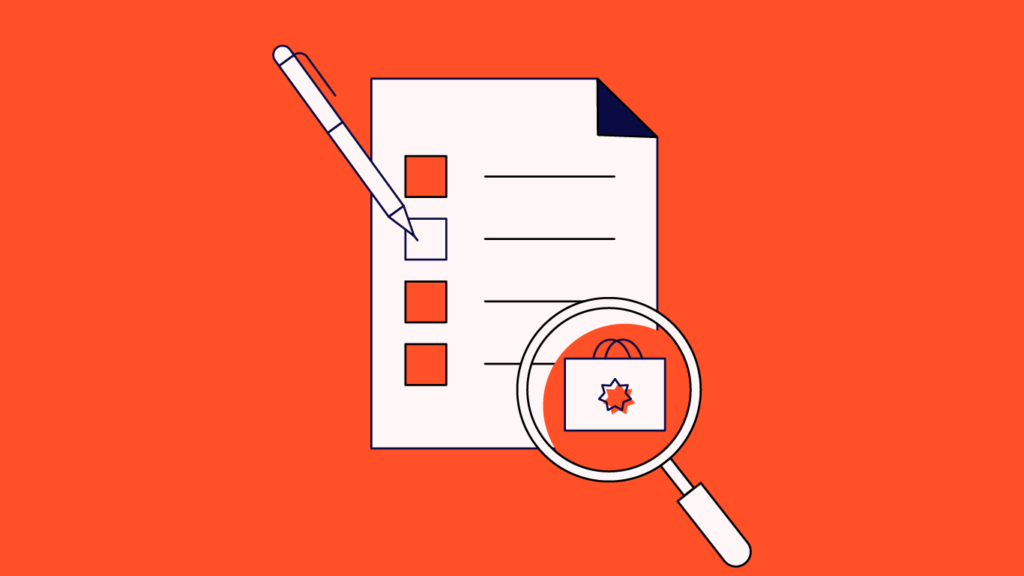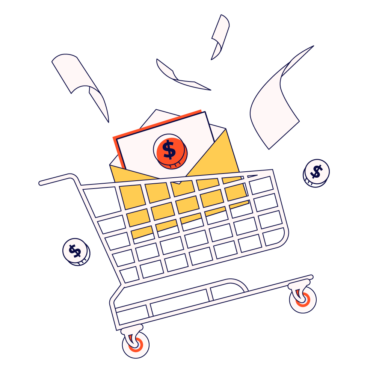Product attributes are key to getting your brand noticed in the increasingly crowded ecommerce marketplace.
Brands need to offer potential customers what they want in a format that makes it easy for the average joe or jane to find.
With the flexibility offered by modern ecommerce platforms, it’s important to understand and take advantage of the opportunities within strategic product attribution.
Use product attributes to show up in search engines and speak to shoppers’ extremely specific needs and wants. When we match our classification of products on the product details page according to consumer behavior and habits, we’re in business.
Shoppers look for and buy goods and services with specific product attributes.
Ecommerce marketers must hone their target audience and build product descriptions that capture customers' desires. Using product attributes in your marketing strategy is critical in attaining brand success.
Each specific attribute must be a positive selling point to create a lasting impression. Let's start by defining the concept and narrow in on the specifics as we go.
What are Product Attributes?
Product attributes refer to the characteristics of a product that define how customers research and buy.
Your brand internally identifies products using a unique code or SKU (stock-keeping unit) to help differentiate between products in its inventory management system. But, your customers see and search for products in very different ways.
Customers use natural language and descriptive words in their search queries, such as “large family tent” or “affordable waterproof jacket.”
Like you, they are humans. Always remember, you are talking to humans.
Tangible vs intangible product attributes
Attributes are further defined as tangible (physical) or intangible (non-physical).
- Tangibles are characteristics such as size, color, smell, product design, weight, etc.
- Intangible refers to things like price, quality, and aesthetics.
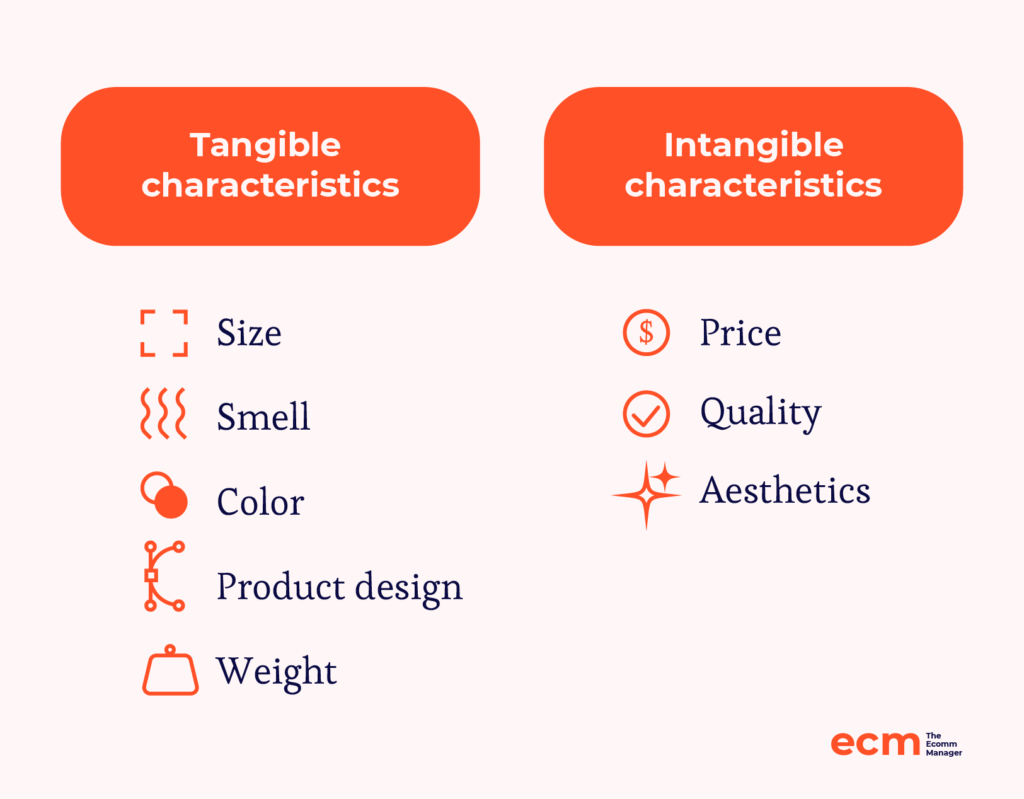
Buyers use a combination of these various product attributes to make a buying decision. They are looking for a product that meets their needs and their wants.
Customer needs are must-haves in a product, and wants are desired but not critical. Buyers select a product that best matches these needs and wants.
Types of Product Attributes
When people search for products, they need to quickly get key details about their options and easily compare them to find the right fit. It's important to list the product attributes that will matter most to your prospective buyer.
Product attributes must be accurate and informative.
Listen to customer feedback, take advantage of reading product reviews (these also help with making product improvements), and understand how your product is meeting, or failing to meet, customer expectations.
Here are the different types of product attributes that can describe your product, plus a few helpful examples of product attributes at work.
Quality
This should be your brand's primary product attribute when pushing for market placement.
People are drawn to products they know and they trust will work. Generating positive reviews and solid manufacturing data are two ways of demonstrating a product’s quality.
This requires work.
Companies that ensure their chain of product development, production, quality assurance, and control, as well as customer service, are all consistent with producing a high-end product will win stellar reviews that validate its quality.
Quality attributes are necessary for the product to get discovered by shoppers and drive sales. Examples of quality-related attributes include:
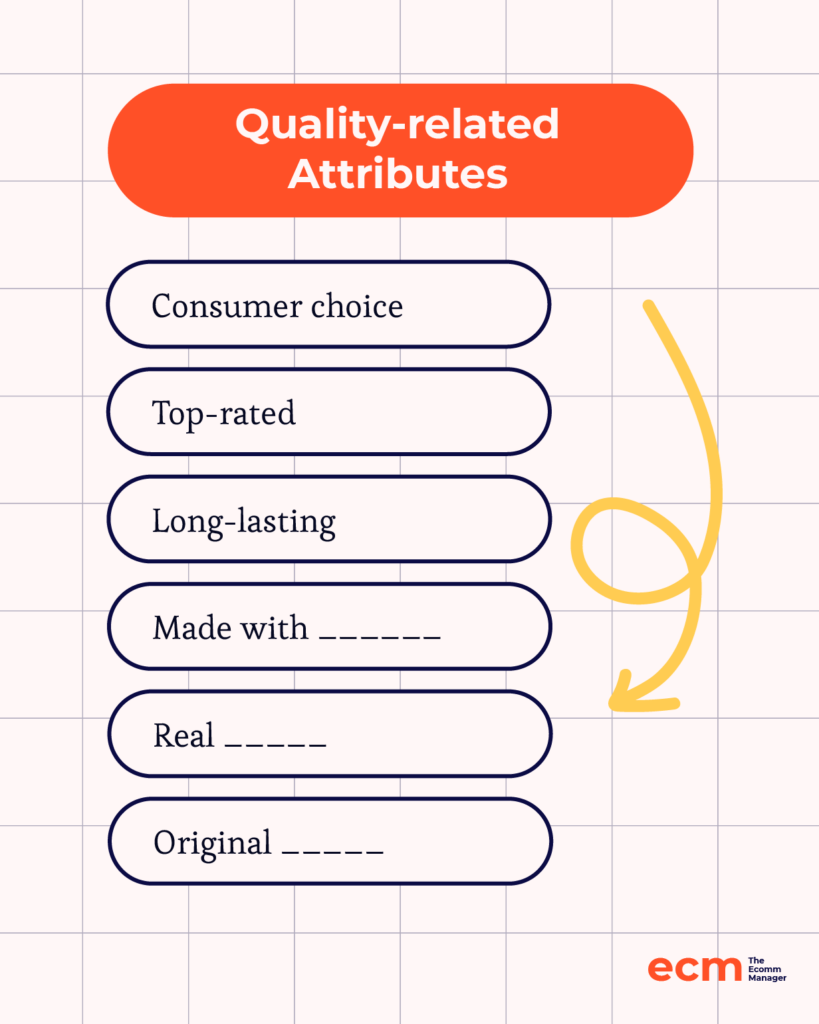
- Consumer choice
- Top-rated
- Long-lasting
- Made with ____
- Real ____
- Original ____
Marketing claims
Marketing claims are those relating to your product's performance.
They can be both objective and subjective. Brands invest time and money into conducting market research via groups and customer surveys to create a persuasive stat to entice customers.
Examples of marketing claim attributes include things like:

- "Cuts grease in seconds"
- "#1 beverage company in the world"
- "Kills 99.9% of germs"
- "Made of 100% cotton"
However, it's important to be aware that false claims, or statements modified to twist attributes, can cause marketing problems.
A dishonest or weak claim can devalue your product and brand.
While this can fool shoppers into buying once or twice, the product will ultimately fail to live up to the hype you created and customers will shop elsewhere. Even worse, you may have to contend with bad reviews on top of the inevitable churn.
Extensive testing to verify and support marketing claims will help avoid the problem of misidentifying product attributes and strengths.
Consumers will find your products through accurate product marketing claims and become repeat buyers when those claims are verified through a great customer experience.
Innovative attributes
Some products and services in the marketplace have been around for generations.
Items like laundry or cleaning products are perfect examples. However, if your company wants to stay ahead of the regular market brands, innovations can help reinvigorate sales.
Keeping products fresh, whether well-established or new to the market, can be achieved by mining the data of a product category to analyze, assess, and rework products.
This allows you to create next-generation products built on a strong foundation of tried and true products with loyal customers.
Focusing on increased reliability, a new look, extended shelf life, sustainable materials, and other needed improvements can differentiate your product and attract new customers.
Verification and safety
While color or size attributes can influence a customer's purchase, another very important tangible attribute is a product’s proven safety credentials. You can't ignore this variant, as shoppers deeply value trustworthy and safe products.
Examples of verification-related attributes are:
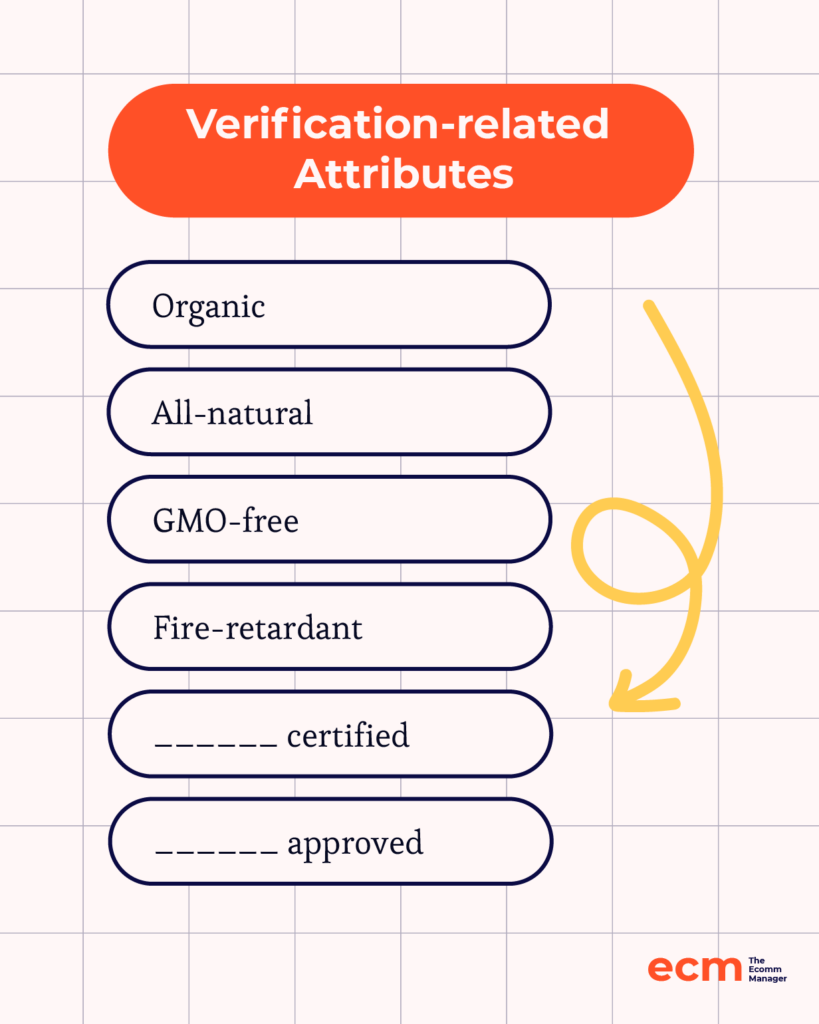
- Organic
- All-natural
- GMO-free
- Fire-retardant
- _____ certified
- _____ approved
All these attributes are critical to making the consumer feel safe that the product can be trusted.
Verification studies can be conducted at specialized labs to meet all safety needs. This works in any area of product and service support.
Catching product and service issues before a product hits the market also means fewer negative reviews and reduces the chance of product recalls and returns. Verified safety attributes will help consumers find your products and feel good about buying them.
17 Product Attributes That Motivate Purchases
The list of tangible and intangible product attributes is nearly endless. Here's a comprehensive (but by no means exhaustive) list of product attributes:
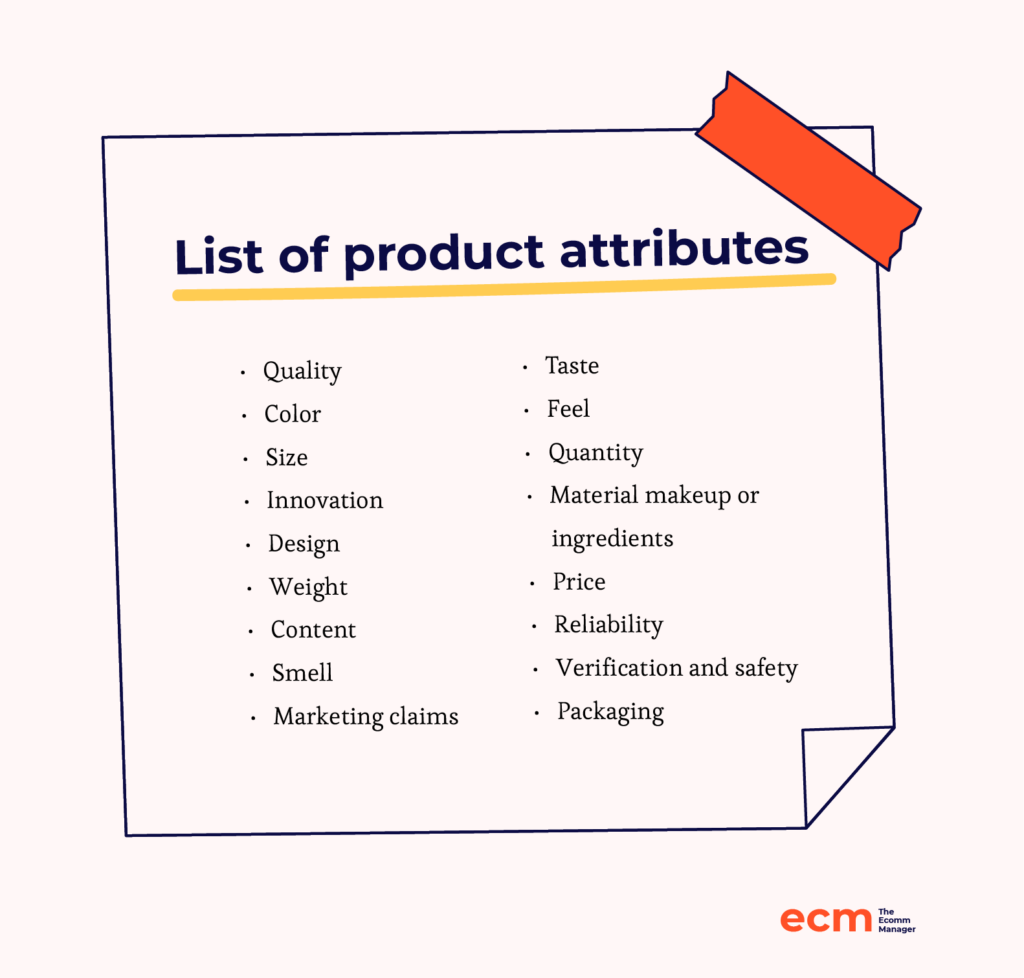
- Quality: This refers to how well the product performs in relation to its intended purpose and its durability over time. High-quality products are usually made from superior materials, manufactured with precision, and have less likelihood of defects.
- Color: This relates to the product's hue, saturation, and brightness. Color also influences customer purchasing decisions, as it often conveys certain emotions or meanings.
- Size: Size pertains to the physical attributes of the product, like length, width, and height. It also could include volume or capacity, depending on the product type.
- Innovation: This refers to how novel or advanced the product is regarding technology or ideas. An innovative product often has unique features or functionalities that set it apart from its competitors.
- Design: Design encompasses both the aesthetic appearance and the product's functionality. It involves the shape, color, texture, and ergonomic features of a product that make it comfortable and easy to use.
- Weight: This is the measure of how heavy the product is. Weight can impact shipping costs, ease of use, and even the perceived quality of the product.
- Content: This could refer to what's included in the product package or the actual information or features contained in a product, especially for digital or media products.
- Smell: For certain products like food, beverages, perfumes, and cleaning products, the scent or odor can greatly influence customer satisfaction.
- Taste: This attribute is crucial for food and beverage products. It refers to the flavor profile, which could be sweet, sour, salty, bitter, umami, or a combination thereof.
- Feel: The tactile sensation when a customer interacts with the product. It could refer to the texture, hardness, temperature, or weight of the product.
- Quantity: Quantity pertains to how much of the product is sold in a single unit or package. This could refer to the number of items, the volume, or the weight.
- Material composition or ingredients: Literally, it's what is in the product. For food items, this would be the ingredients list. For non-food items, it could be the type of fabric, metal, or plastic used.
- Price: This is the cost to the customer to purchase the product. Price is often a key deciding factor for consumers and can reflect the product's perceived value.
- Reliability: Reliability pertains to how consistently the product performs its intended function without failures over a certain period.
- Verification and safety: Verification refers to the processes in place to ensure the product meets specific standards or claims. Safety relates to the product's potential risks or hazards to the user.
- Packaging: This involves how the product is presented and protected. Good packaging can enhance the product's appeal, provide important information, and ensure the product reaches the customer undamaged.
- Marketing claims: These are statements made by the brand about the product's features, benefits, or performance, used to persuade customers to buy. They should be truthful and verifiable (for example, through case studies or consumer research).
Use this list to highlight the right attributes and ensure they help consumers find the product and trigger them to buy.
This list can help marketers highlight a custom product’s attribute selection and ensure customers see these positives in their online product searches. Product attributes should be easy to find in product descriptions, under an attributes tab or menu, or on the main page.
If you're looking for ways to manage and optimize your product attribution list, check out the 10 Best PIM Software for Product Information Management.
Put Your Product at the Forefront
Marketing a product or service needs more than just promoting the same old features.
Using product attributes that are strong, positive, and true can help you stand out in a crowded and competitive market.
Highlight your product positives, name a custom attribute that makes the product shine, and do everything possible to surpass every competitor's claim.
Your ecommerce site (and your customers' search results) should emphasize what you sell and what sets you apart from the rest.
Find this useful? Receive all the latest ecommerce insights and generous advice from industry leaders by subscribing to The Ecomm Manager newsletter.
Product Attributes FAQs
For everything we couldn’t directly cover in the post, there are FAQs!
Can product attributes improve online visibility and SEO?
Product attributes can boost online visibility and SEO by incorporating relevant keywords in product titles, descriptions, and meta tags, making the products more discoverable to those searching for specific items.
Structured data markup for product attributes enhances search results with rich snippets, leading to higher click-through rates.
Incorporating dynamic attributes like customer reviews and ratings provides fresh, SEO-friendly content and contributes to a store’s relevance and authority, further improving search engine rankings.
What are the best practices for displaying product attributes online?
Displaying product attributes online effectively involves prioritizing clarity, comprehensiveness, and customer focus.
Key attributes should be immediately visible, using bullet points for quick scanning. Employing high-quality visuals that show the product from various angles or in use can offer a clearer perspective.
Concise, detailed descriptions that highlight the key features and benefits tailored to customer interests can significantly enhance product appeal. Including customer reviews adds a layer of social proof, building customer trust.
Interactive elements, like image zoom and color options, along with ensuring mobile responsiveness, greatly improve user experience and engagement.
What role does AI play in the management of product attributes?
AI changes how we manage product details by making updates faster, making suggestions more personal, and making information more accurate.
It looks at a lot of product data to spot trends and quickly adjusts details to match what shoppers want. AI tools help suggest products that fit each user’s interests, making shopping more enjoyable. It also makes searching easier by better understanding what people are looking for and showing them matching products.
By handling product information automatically across different places, AI reduces the need for manual work and mistakes, making online selling more efficient.
How do product attributes influence online shopping behavior?
Product attributes directly impact online shopping behavior by offering essential insights that help shoppers make informed decisions.
Attributes like price, material, size, color, and brand communicate a product’s value and suitability to the shopper’s needs. Visual elements like high-quality images and videos play a critical role in enhancing product attractiveness, enabling shoppers to better visualize the product in their own space.
Detailed descriptions and technical specifications provide deeper insights into your product benefits and features, addressing potential questions and concerns.
Effectively presented attributes can mitigate the perceived risks of online shopping, lead to more confident purchasing decisions, and increase customer satisfaction and loyalty.
More great ECM content:
- What Is PIM Software & How Much Does It Cost?
- 6 Product Information Management Best Practices
- Unleash The Power Of PIM Data: 6 CEO-Endorsed Tactics For Ecommerce
- 10 Best Product Information Management (PIM) Software
- 10 Best Catalog Management Software
- 10 Best Ecommerce Product Data Management Software
- 10 Best Retail Management Software

